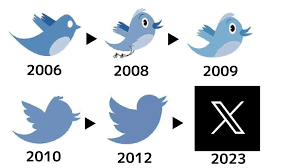In the ever-evolving realm of social media, where platforms are both arenas for branding battles and hubs for community conversations, Twitter’s transformation into ‘X’ has become a fascinating study in corporate identity evolution. This was mentioned during the Social Pros Unfiltered episode by Sunny Hunt, Strategist at Convince and Convert, and really got me thinking about its implications and lessons.
This significant shift has created waves in the industry, sparking lively discussions among marketers, branding gurus, and everyday users. A recent Pew Research Center survey shows a split in opinion – 42% in favor, 38% against, and 20% undecided – making ‘X’s journey an interesting topic for analysis.
The rebranding of a social media titan such as Twitter isn’t just a cosmetic alteration; it’s a strategic overhaul that seeks to redefine the platform’s essence. For ‘X’, it signifies a move towards what many believe to be an ambitious, if not enigmatic, new era.
But amidst these bold moves, an important question arises: How do we navigate the complexities of such a major shift in social media identity?
Were you in favor of X's rebrand of Twitter? Click To TweetThe Rebranding Quandary: Twitter’s Transition to X
When a well-known brand like Twitter rebrands, it’s not just a new look; it’s a complete repositioning of its identity. ‘X’ is more than a fresh name; it’s a pledge for a new direction, a huge task in changing public perception and user habits.
Sunny mentioned on Social Pros Unfiltered that the rebrand seemed less like a strategic move and more of a lesson in the risks of rebranding without clear direction and execution.

Understanding the ‘Why’ Behind Rebranding
A successful rebrand hinges on understanding the ‘why.’ Before even considering a rebrand, companies must ask themselves: What do we hope to achieve? Is it to refresh the image, reach a new audience, or signify a major shift in direction? For X, the reasons behind the rebranding are lengthy yet still opaque, leading to confusion and skepticism amongst half of its user base.
Reasons for the rebrand from X’s perspective are:
- Elon Musk’s ambition to create a new identity for the platform formerly known as Twitter in an attempt to make it an “everything app”.
- “Twitter” as a name was no longer accurate with it formerly being a platform for short, 140-character messages. “X” is more open-ended and allows for the evolution of users to post longer messages, images, videos and live streams.
- Musk wanted to put his own stamp on Twitter. He wants Twitter to be more transparent and accountable to its users.
Execution is Key
In marketing, we often face sudden shifts like those with Threads, ChatGPT, and Google Analytics 4. Some come without warning, while others give time to prepare.
The execution of ‘X’s rebrand seemed rushed and unplanned. A successful rebrand should be methodical, covering everything from domain acquisition to trademarking. Sunny’s critique pointed out these missing elements in X’s approach.
Additionally, not adequately educating users on the rebrand’s significance led to a disconnect, which could have been eased with a stronger communication strategy.
Consistency Across All Touchpoints
A rebrand isn’t complete without a consistent rollout across all touchpoints. From the user interface to marketing materials, everything should mirror the new identity. This helps in building recognition and reinforces the rebrand, something ‘X’ could have better utilized.
A more gradual introduction would have eased users into the new branding and features.
User-Centric Approach
The user base is a brand’s most valuable asset, and any rebranding effort should put their experience at the forefront. X’s rebrand could have benefited from a more user-centric approach, actively involving the community in the transition and ensuring the changes resonated positively with them.
Gathering user feedback pre-launch could have identified and addressed potential issues with the rebrand. Did other marketers also ponder the UX and accessibility implications of using “X” as the close button in some browsers? We did too.
Leveraging Data and Feedback
In today’s social media world, immediate user feedback and data are invaluable. Used wisely, they can greatly inform rebranding strategies, aligning them with user expectations and behaviors. ‘X’ showed how overlooking this resource can be a pitfall.
If ‘X’ had utilized data and feedback, they could have identified:
- Strengths and weaknesses of the current brand.
- User reactions to the new name and brand.
- Confusions or issues with the rebrand.
- Current trends and opportunities with users.
A Clear Narrative
A compelling narrative is key in rebranding. What story does the new brand tell, and how does it align with the company’s vision and user needs?
While still developing, ‘X’s narrative focuses on innovation and disruption. Musk’s vision of ‘X’ as “the everything app” and a platform for open and free speech is evident, though the articulation of this narrative left users more puzzled than engaged.
Maintaining Brand Equity
For a platform like Twitter, now ‘X’, there’s immense built-up brand equity. A rebrand should build on this equity, not discard it. It’s about evolving, bringing users along, and maintaining core values while introducing new, progressive elements.

The Role of Market Research
Extensive market research should precede any rebrand. Understanding the competitive landscape, audience sentiment, and social climate is crucial. ‘X’ seems to have missed this stage, leading to a rebrand that felt disconnected from wider social conversations.
The rebrand came at a time of heightened public concern about misinformation on social media. Musk’s vision for a more open platform raised fears of increased misinformation and disinformation. The ‘X’ name also appeared elitist to some, disconnecting from the average user.
Post-Rebranding Strategy
Finally, rebranding is not the end but the beginning of a new chapter. It requires a comprehensive post-rebranding strategy that includes monitoring, tweaking, and continual engagement with users. Xs trajectory post-rebrand will be telling of how well they understand and implement this.
For brands considering a rebrand, the case of X underscores the importance of strategic planning, clear communication, and user engagement. In a domain where your users are your most vocal critics and advocates, the act of rebranding should be as collaborative as it is strategic. X stands as a testament to the weight of a name and the complexities it carries—a lesson for all in the realm of social media branding.
As we continue to watch the evolution of X, let’s take the insights from this podcast episode and apply them to our own practices. Whether you’re a social media manager, a brand strategist, or a marketer, the rebranding of X teaches us that in the world of social media, change is the only constant, but how we manage that change can make all the difference.
Don’t forget to listen to:


